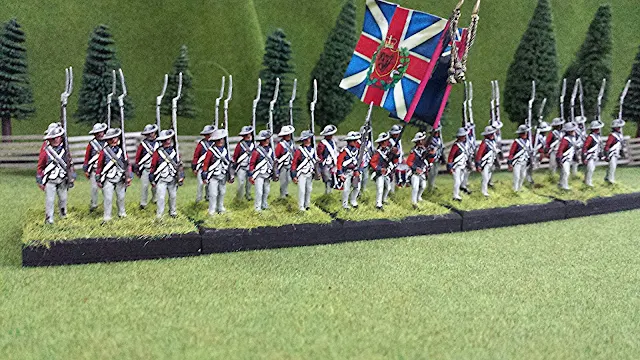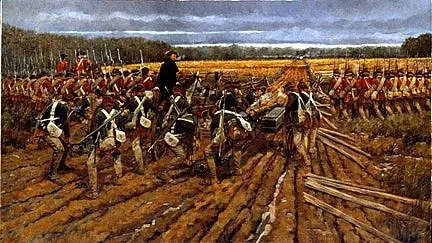Saturday, June 3, 2017
Southern militia 1781
At the surrender of Charleston South Carolina the entire South Carolina Continental line were taken prisoners. Local militia were soon adopted into a State line and many battalions saw extensive service for the next two years.
Although not uniformed they were reasonably well drilled and equipped. Most wore civilian clothing, or the traditional hunting shirt. Equipment varied but interestingly both muskets and rifles saw service together (which must have been a quarter masters night mare).
On the battlefield they might not have the disciple of regulars but could still give a good accounting of themselves. Many battalions were in the field for long periods of time so should be thought of a almost regulars, perhaps a level below them. They did have a habit of coming and going, but on the whole they were a valuable addition for Greene's army and a force multiplier.
Rather then traditional hunting shirts I have my militia in civilian clothing. Gives a nice look to them. I have added flags but I have no period documentation for them. As with many things on the table top they are there because they look nice.
For an interesting read I would recommend; "True for the Cause of Liberty: The Second Spartan Regiment in the American Revolution." By Oscar and Catherine Gilbert.
Figures are all from Fife and Drum miniatures while flags are from Flags of War.
Friday, June 2, 2017
Loyalist brigade
Getting ready for my campaign, I have been fiendishly painting and finishing up my Rev War forces. Number one in my projects have been my loyalist forces. Often down played in the history books, the various loyalist forces (American Establishment, regulars, militia and refugees) played an incredible role in the south from 1779 to 1783. Yet, with little and often contradictory information out there they are a misunderstood organization and their uniforms poorly documented. Because of this there is not much historical documentation for my loyalist brigade, but lots of conjecture. Both of my regiments are long service veterans who are members diverge American Establishment. As one gamer said, they are more British then the British.
New York Volunteers
(3rd American regiment)
One of the very first loyalist fighting regiments. They served at Long Island although "dressed in rags." Sent south with Colonel Archibald Campbell in 1779 they fought in Georgia and South Carolina. After their defense of Rocky Mount their commander Turnball suggested they were given a standard.
My uniform is based on returns in 1782 which suggest they wore red coats faced blue. Prior to that it is very unclear and contradictory. As part of the American Establishment they received yearly clothing and equipment like British regular regiments from the same sources. So I have used regular British figures. The gray round hats is purely fantasy as I like the illustrations in Mollo and McGregor "Uniforms of the American Revolution." I can find no contemporary source for this and admit it is conjecture. But they were one of my favorite regiments of the period and I wanted to make them stand out.
Volunteers of Ireland
(2nd American regiment)
Here I have flown in the face of conventional wisdom and interpret the volunteer differently. Most modern depictions suggest the Volunteer of Ireland look like this Trioni illustrations .
This is how the perry brothers have modeled them. I believe this is due to two items. One a contemporary return suggesting caps trimmed silver for sergeants in 1782. The other is a engraving of Rawdon with a possible drawing of some of his soldiers. Here is the drawing:
While these interpretation might be true I am not sure. The coat and illustrations of Rawson were done after this time period. The illustrations of the soldiers suggest almost grenadier miters caps not the low light infantry type cap. I can find no returns before 1780 for the coats suggested. In fact returns from 1780 and before suggest regular uniforms and equipment issued. As to the caps were they for the Light company?
So I have painted my version of the Volunteers of Ireland in red coats faced green and given them round hats (much more comfortable in the heat of the south and better documented).
Again, I am saying this is my interpretation. It is not more right or wrong then what others have done. It is my interpretation based on the evidence I look at. As with so much in history please read your source material and draw your opinion.
Thursday, June 1, 2017
Royal Marine Artillery Rocket battery 1814
"And the rockets red glare..."
Come on, how can you do War of 1812 and not have a rocket battery! It's down right unpatriotic! Mine comes from Old Glory's Napoleonic line. In Canada they used the tripod rather then the smaller launcher. I left out the Royal Horse Artillery crew (who might return if I ever do New Orleans) and substituted Royal Marine Artillery crew who manned in Canada. These men wore the same uniform as the Royal Artillery but with white, not yellow lace. These figures are from Knuckleduster miniatures. Especially love the officer looking up!
For rules I wanted rockets to be dangerous to friend and foe. And unpredictable. So when fired they might hit the enemy, they might disappear or they c I had double back and hit the battery. You roll your dice and takes your chances. Good luck!
Also, a word of thanks to my mentor in the War of 1812. Rod Schwagger has patiently guided me pass numerous pitfalls, explained best up to date research and where to get figures. He has suggested books I buy, and one's to stay away from. He has never laugh at my crazy questions but answered them in a thoughtful manner. It is a pleasure to have met him, if only in the internet. Thank you sir! I could not have done this without your help.
If you can please visit Rod's blog at http://warof1812war-gaming.blogspot.com/2017/02/battle-of-chippewa-second-session-1st.html
If you can please visit Rod's blog at http://warof1812war-gaming.blogspot.com/2017/02/battle-of-chippewa-second-session-1st.html
Wednesday, May 31, 2017
Benedict Arnold and the First battle of Saratoga.
A great number of years ago I published an article on the role of Benedict Arnold during the first battle of Saratoga. There is an academic controversy concerning his actual role in the fighting that day. While most articles I have read concentrated on how historians view this, I approached it a bit differently. I went back and examined all first person accounts of participants in the Battle.
If you interested in reading this, here is the link to the article. But be warned! It is dry and may cause you to nod off.
file:///data/data/com.amazon.cloud9/app_saved_pages_dir/1741ab5b41-df54-4c31-bb51-f4b1f6c0f96d.mht
Thursday, May 25, 2017
View of Breed's Hill after the battle c. 1775
Original water color by artist Thomas Davis in 1775. View at base of Breed' hill looking up hill. The redoubt and breastwork are illustrated. Remains of various fences scattered about field. By the officers and soldiers in foreground note plants suggesting wet ground. This is area where British guns were bogged down.
A brigade order in Boston said the men may cut their hats, in the manner the 4th have done. These soldiers hats suggest how that should look. As to the fellow sitting down under the shade of the tree to the left he could be a light infantryman.
https://digitalcollections.nypl.org/items/96705235-c441-f877-e040-e00a18065df4
Sunday, May 14, 2017
Club game night
Last night was club game night. Ed and George invited me, and I was excited to go again. It had been a difficult night at work the night before (flight crews timed out and medical emergency so I did not leave work till after midnight) and it is always great fun to see and game with old friends.
As is usual there were three outstanding beautiful games. Mike put on a scaled down version of Trafalgar with Sails of glory. A great fun, and very beautiful game. Have to look into it more. Ralph staged a firefight of Cannane. Beautiful terrain and incredibly well done troops. A superb game as only Ralph can do. Both looked great and from the sounds of it all of the players had a great time.
I was fortunate to play in Ed's game of The Battle of Dybboll (May 28, 1849). The was during the First Schleswig-Holstein War 1848-49. Troops (Denmark, Prussian and German Federation) are all pretty much equal. The Prussians are not the army of the needlegun nor von Molkle. In fact they are quite average. It is a very colorful and evan fight, which historical Denmark won. The rules used were Volley and Bayonet. Ed put an incredible amount of work into this with amazing figure conversions and outstanding game devices to record losses and brigade status. Just really first rate!
For more on the game I would recommend you check out Ed's blog (Ed M's Wargame Meanderings) here http://edmwargamemeanderings.blogspot.com/2017/05/danish-delight-battle-of-dybbol-5-june.html
or AJ's blog for a write up of a game test here http://ajs-wargaming.blogspot.com/2017/05/battle-of-duppel-28-may-1849.html. Both will give a better understanding of the game then I can.
 |
| Prussian Hussars capture the battery |
 |
| Over running the Infantry |
 |
| Some of Ed's beautifully done troops. |
 |
| Prussian brigade advancing |
 |
| Fire fight while the Guards move towards the woods |
From my point of view the game was great fun. Bob's Dannish cavalry caused no end of damage and mischief, destroying George's artillery before they could come into action. I returned the favor by reenacting "von Bedlow's Death Ride" against Bob's artillery and infantry. Who said cavalry is useless! I managed to out flank the Dannish line through the woods with my guards brigade while my line held his attention. Alas, it was too little to late as the Dannish forces held on to win the game.
A great night was had by all! Beautiful painted figures, on excellent terrain and great camaraderie with friends. It does not get any better then this!
Cheers 🍺
Thursday, May 11, 2017
British Order of Battle Guilford Courthouse Campaign
British Southern Army: December 1780 to March 1781
Lieutenant General Lord Charles Cornwallis
Webster’s Brigade: Colonel James Webster
7th Regiment of Foot (24)
23rd Regiment of Foot. (30)
33rd Regiment of Foot. (30)
Brigade of Guards: General Charles O'Hara
Guards Light Infantry Company (12)
Guards Grenadier Company (12)
1st Guards Battalion (30)
2nd Guards Battalion (30)
Reserve Brigade: Major General Leslie
1st Bn/71st Highland Regiment (24)
2nd Bn/71st Highland Regiment (24)
von Bose Regiment (Trumbach) (30)
Unbrigaded:
British Light Infantry battalion (12)
Jaeger company (9)
Royal Artillery ( 6-pdr & 3-per)
British Legion: Lt. Colonel Banastre Tarelton
British Legion Dragoons
1st Squadron/British Legion Dragoons: (8)
2nd Squadron/British Legion Dragoons: (8)
3rd Squadron/British Legion Dragoons: (8)
British Legion Infantry (24)
British Legion Artillery (3-pdr)
17th Light Dragoon (6)
Camden Brigade:
Lt. Colonel Lord Rawdon
Royal North Carolina Regiment (30)
Volunteers of Ireland Regiment (30)
New York Volunteers Regiment (24)
South Carolina Royalist (24)
Coffin's Dragoons (6)
Camden District Loyalist Militia (30)
Royal Artillery (6 pdr)
Ninety-Six, South Carolina
Cruger's Loyalist Brigade:
Lieutenant Colonel John Harris Cruger
1st Bn/Delancey's (18)
3rd Bn/New Jersey Volunteers (24)
South Carolina Royalists (30)
Loyalist Artillery (2 x 3-pdr)
96th District South Carolina Loyalist Militia Brigade:
Brigadier Robert Cunningham
King's Long Cane Loyalist Militia (24)
Cunningham's Little River Loyalist Militia (24)
Stevens Creek Loyalist Militia (24)
Dunlap's Loyalist Dragoons (6)
Note: For March into North Carolina against Greene's army Cornwalis may take with him Webster's Brigade, Guard's brigade, Reserve Brigade, British Legion , unbrigaded troops and North Carolina Loyalist regiment.
Subscribe to:
Posts (Atom)

















